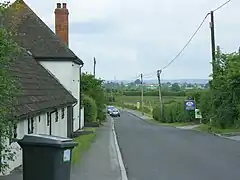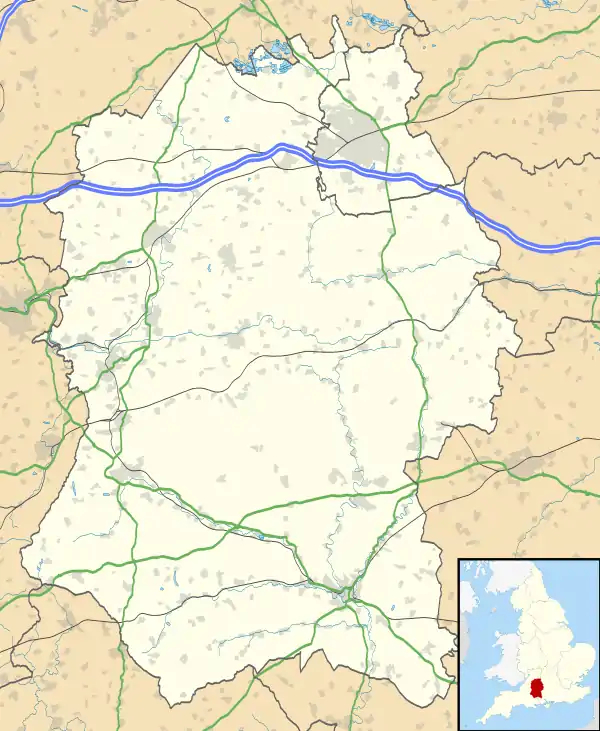Heywood, Wiltshire
Heywood is a civil parish and small village in the county of Wiltshire in southwestern England.[2] The village is approximately 1.5 miles (2.4 km) north of Westbury and 3.5 miles (5.6 km) south of the county town of Trowbridge.
| Heywood | |
|---|---|
 Church Road, Heywood | |
 Heywood Location within Wiltshire | |
| Population | 798 (in 2011)[1] |
| OS grid reference | ST873536 |
| Civil parish |
|
| Unitary authority | |
| Ceremonial county | |
| Region | |
| Country | England |
| Sovereign state | United Kingdom |
| Post town | Westbury |
| Postcode district | BA13 |
| Dialling code | 01373 |
| Police | Wiltshire |
| Fire | Dorset and Wiltshire |
| Ambulance | South Western |
| UK Parliament | |
Heywood village, which has approximately 200 inhabitants, lies between the A350 national route and the B3461 road, which links nearby Yarnbrook and the Westbury industrial area. The hamlet of Dursley is situated directly to the west of the village on the other side of the railway line. The parish also includes the hamlets of Hawkeridge and Norleaze; in the south are the West Wilts Trading Estate and part of The Ham, close to Westbury.
The Biss Brook forms the west and northwest boundary of the parish.
History
For most of its history, Heywood formed part of the parish and hundred of Westbury. From the 13th century the manor of Heywood was an estate of Stanley Abbey. It was acquired by Sir Edward Bayntun in 1537; later landowners included the Long family and the Earls of Marlborough.[3]
In 1848 the Wilts, Somerset and Weymouth Railway was built through the parish, passing between Heywood and Dursley, to link the Swindon-Bath line (near Chippenham) with Westbury via Trowbridge. This line remains open.
The civil parish of Heywood was created in 1896 from the northern section of Westbury parish; part of Heywood was transferred back to Westbury in 1909.[4]
Brook Hall
Brook Hall, in the west of Heywood parish near the Biss Brook, is a c. 1600 farmhouse which incorporates a Grade I listed wing of a 15th-century manor house.[5]
Heywood House
James Ley (Member of Parliament for Westbury, and later Lord High Treasurer and Earl of Marlborough), and his brother Matthew (also MP for Westbury) acquired land at Heywood in the early 17th century, and James built a house there.[6][7] Around 1700 this house was owned by the Phipps family, cloth merchants; William Phipps, a former Governor of Bombay, died at the house in 1748. Later in the century the house came into the Ludlow family, and in 1837 Henry Gaisford Gibbs Ludlow had the present Heywood House built on the same site, east of the present A350.[3]
On Henry's death in 1876 the house passed to Henry Charles Lopes, of the Lopes family who owned Westbury manor. Henry Lopes was created Baron Ludlow in 1897; the title became extinct in 1922 on the death of his son, also Henry Lopes. Since then the house had several owners and for a time housed the headquarters of the National Trust; in 1987 it was designated as Grade II* listed.[3] The house is now multi-tenanted offices.[8]
Governance
From 1935 until 1974, Heywood was part of the Warminster and Westbury Rural District, which was abolished by the Local Government Act 1972, when it joined the new West Wiltshire district.[9] Since the abolition of West Wiltshire as a district in 2009, all significant local government functions have been carried out by the new Wiltshire Council unitary authority.
The member of parliament for Heywood is Andrew Murrison (Conservative).
Religious sites
A small Congregational church was built at Hawkeridge in 1844.[10] As of 2015 the church remains in use.[11]
The Church of England parish church of the Holy Trinity was built in 1849 and served a new ecclesiastical parish which was formed from the northern part of the parish of Westbury.[12][13] The building is in the 13th-century style; Pevsner describes the east window of 1876 as "especially horrible".[14] The church closed in 1981[15] and was converted for residential use.
Amenities
There is a pub at Hawkeridge, the Royal Oak.
The village primary school was closed in 1971.[16] It had been built in 1836 at the expense of Henry G.G. Ludlow and educated children of all ages until 1930.[17]
Tumblewood Community School, near Dursley, is a specialist school for girls.[18]
Notable people
- John Barnard Bush, Lord Lieutenant of Wiltshire 2004 to 2012[19]
References
- "Wiltshire Community History – Census". Wiltshire Council. Retrieved 11 December 2015.
- Visions of Britain
- Historic England. "Heywood House, Heywood Park (1284971)". National Heritage List for England. Retrieved 12 December 2015.
- "Victoria County History – Wiltshire – Vol 8 pp 139–148 – Westbury: Introduction". British History Online. University of London. Retrieved 12 December 2015.
- Historic England. "Early Wing at Brook Hall (1285019)". National Heritage List for England. Retrieved 15 December 2020.
- "LEY, Matthew (c.1545-1636), of Westbury and Teffont Evias, Wilts". History of Parliament Online. Retrieved 13 December 2020.
- "Victoria County History – Wiltshire – Vol 8 pp148-163 – Westbury: Manors". British History Online. University of London. Retrieved 12 December 2015.
- Yilmaz, Tanya (10 May 2015). "Businesses encouraged to relocate to Heywood House". Wiltshire Times. Retrieved 12 December 2015.
- unit history of WARMINSTER AND WESTBURY at visionofbritain.org.uk, accessed 26 March 2012
- "Victoria County History – Wiltshire – Vol 8 pp181-185 – Westbury: Protestant nonconformity". British History Online. University of London. Retrieved 12 December 2015.
- "Hawkeridge". The Congregational Federation. Retrieved 12 December 2015.
- "Victoria County History – Wiltshire – Vol 8 pp176-181 – Westbury: Churches". British History Online. University of London. Retrieved 12 December 2015.
- "No. 20996". The London Gazette. 6 July 1849. pp. 2156–2157.
- Pevsner, Nikolaus; Cherry, Bridget (revision) (1975) [1963]. Wiltshire. The Buildings of England (2nd ed.). Harmondsworth: Penguin Books. p. 268. ISBN 0-14-0710-26-4.
- "Holy Trinity Church, Heywood". Wiltshire Community History. Wiltshire Council. Retrieved 12 December 2015.
- "Heywood Voluntary Controlled School". Wiltshire Community History. Wiltshire Council. Retrieved 12 December 2015.
- "Victoria County History – Wiltshire – Vol 8 pp188-191 – Westbury: Schools". British History Online. University of London. Retrieved 12 December 2015.
- "Tumblewood Community". Retrieved 12 December 2015.
- London Gazette dated 9 December 2004, Notice: 1001 (Issue: 57490): "The QUEEN has been pleased by Letters Patent under the Great Seal of the Realm dated 10 November 2004 to appoint John Barnard Bush, Esquire, OBE, to be Lord-Lieutenant of and in the County of Wiltshire."
- W. H. Hamilton Rogers, The Strife of the Roses & Days of the Tudors in the West (Exeter: 1890): on-line text
External links
![]() Media related to Heywood, Wiltshire at Wikimedia Commons
Media related to Heywood, Wiltshire at Wikimedia Commons